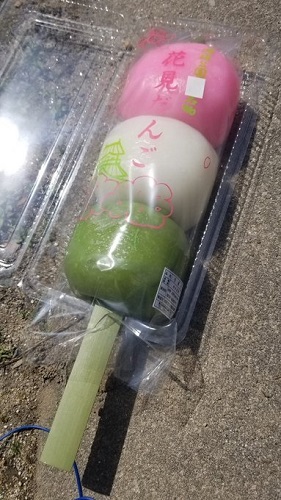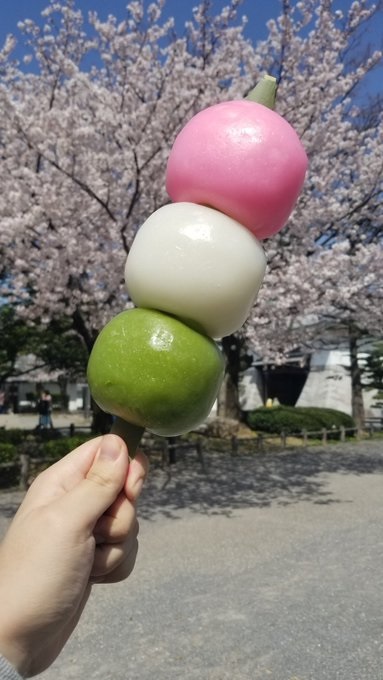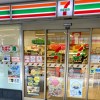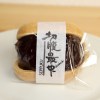
Some dango are built different, and some are built to destroy our jaws.
Made out of sticky, glutinous rice flour and one of the many dumplings existent in Japanese cuisine, dango is a popular year-round snack with different varieties depending on the season. One of the most popular types in spring is sanshoku (“three-color”) dango, a skewer of pink, white, and green dango, which is also known as hanami dango for its ubiquitous presence at hanami (cherry blossom viewing) outings.
However, for Japanese netizen @81292_II, instead of buying your typical hanami dango, they decided to go above and beyond with gigantic hanami dango, much to the joy and amazement of Japan’s Twitter-verse.
▼ “Any mention of the Okazaki Sakura Festival and I think of this. Gigantic hanami dango!!”
https://twitter.com/81292_II/status/1377113457762295809Purchased at Okazaki Park in Aichi Prefecture and consisting of humongous dango skewered on a piece of bamboo, the massive stick of hanami dango strikes onlookers with awe as well as fear. Our jaws definitely felt some sympathy pain when we tried to imagine fitting just one of those into our mouths.
▼ In a previous year, @81292_II also photographed a comparison between your typical hanami dango and the gigantic one they bought.
https://twitter.com/81292_II/status/1114071772226183168Twitter users gathered to not only share their impressions on the larger-than-life dango but also to exchange memes and jokes:
“Bring this to a swordfight and you’ll be guaranteed certain victory!”
“Can… can one person seriously finish all of that?”
“Instead of a three-color dango, it’s more like a three-meal dango.”
▼ Some folks pitched in with references: one common one was NHK’s educational cartoon Zenmai Samurai, whose protagonist wields a “Dango Blade.”
これ思い出しましたww pic.twitter.com/jg6TjBjKr7
— ぽなペン@ (@LY1G4qJeNepy7AP) March 31, 2021
For those who are curious about hanami dango’s colors, the pink dango gains its cheery hues from food coloring whereas the green dango is made from mixing mugwort with the glutinous rice flour.
One netizen also posted a lovely infographic about the symbolic meaning of hanami dango. Traditionally, the dango features the colors pink, white, and green, each representing a different aspect of spring. Pink is for the blooming sakura flowers, white denotes the end of snowfall, and green refers to the verdant summers which are to come.
▼ “Good timing as I just learned from my kid’s picture book about what the hanami dango colors mean!”
ちょうど先ほど子供の本で色にも意味があったというのを知ったばかりでした pic.twitter.com/2kZcb8vMQA
— ero23@スプ/ラ2 (@ero23nd) March 31, 2021
No matter how you enjoy hanami this year, whether it’s in a remote location with little people or at home, you can never go wrong with a stick of hanami dango, even if it can barely fit in your mouth. Just make sure to chew it thoroughly when it’s time to eat, however!
Source, images: Twitter/@81292_II
● Want to hear about SoraNews24’s latest articles as soon as they’re published? Follow us on Facebook and Twitter!

 Starbucks releases new sakura Frappuccino in Japan, but does it taste as good as it looks?
Starbucks releases new sakura Frappuccino in Japan, but does it taste as good as it looks? Starbucks Japan unveils new Sakura Frappuccino for cherry blossom-viewing season 2024
Starbucks Japan unveils new Sakura Frappuccino for cherry blossom-viewing season 2024 Starbucks has a mochi ice cream Frappuccino? New hanami dango hack goes viral in Japan
Starbucks has a mochi ice cream Frappuccino? New hanami dango hack goes viral in Japan Starbucks Japan brings sakura sweets to the table for cherry blossom season 2024
Starbucks Japan brings sakura sweets to the table for cherry blossom season 2024 Sakura tacos? The Tokyo treat we didn’t know we needed until right now
Sakura tacos? The Tokyo treat we didn’t know we needed until right now Demon Slayer: Kimetsu no Yaiba gets new roller coaster attractions and food at Universal Studios Japan
Demon Slayer: Kimetsu no Yaiba gets new roller coaster attractions and food at Universal Studios Japan How to order snacks on a Shinkansen bullet train in Japan
How to order snacks on a Shinkansen bullet train in Japan Japan’s new difficult-to-drink-from beer glass protects your liver, but it’s a brutal experience
Japan’s new difficult-to-drink-from beer glass protects your liver, but it’s a brutal experience To combat declining birth rate, Japan to begin offering “Breeding Visas” to foreigners
To combat declining birth rate, Japan to begin offering “Breeding Visas” to foreigners Caffeinated ramen for gamers that you can eat with one hand going on sale in Japan
Caffeinated ramen for gamers that you can eat with one hand going on sale in Japan What’s Your National Stereotype? Japanese Sinking Ship Joke Has Got You Pegged
What’s Your National Stereotype? Japanese Sinking Ship Joke Has Got You Pegged How to use the new floating hologram registers at 7-Eleven
How to use the new floating hologram registers at 7-Eleven New Japanese smartphone prohibits users from taking naked selfies
New Japanese smartphone prohibits users from taking naked selfies Suicide cakes – Sweets to die for
Suicide cakes – Sweets to die for High-fashion Totoro cuddle purse is like an elegant stroll in the forest【Photos】
High-fashion Totoro cuddle purse is like an elegant stroll in the forest【Photos】 Nintendo history you can feel – Super NES, N64, and GameCube controllers become capsule toys
Nintendo history you can feel – Super NES, N64, and GameCube controllers become capsule toys Hello, cosmetics! Clinique teams up with Hello Kitty this summer for first-time collaboration
Hello, cosmetics! Clinique teams up with Hello Kitty this summer for first-time collaboration “The most Delicious Cup Noodle in history” – Japan’s French Cup Noodle wins our heart【Taste test】
“The most Delicious Cup Noodle in history” – Japan’s French Cup Noodle wins our heart【Taste test】 Starbucks releases a cute Frappuccino and Unicorn Cake…but not in Japan
Starbucks releases a cute Frappuccino and Unicorn Cake…but not in Japan Kyoto Tower mascot termination reveals dark side behind cute Japanese characters
Kyoto Tower mascot termination reveals dark side behind cute Japanese characters McDonald’s Japan’s Soft Twist Tower: A phantom ice cream only sold at select branches
McDonald’s Japan’s Soft Twist Tower: A phantom ice cream only sold at select branches Yabai Ramen: What makes this Japanese ramen so dangerous?
Yabai Ramen: What makes this Japanese ramen so dangerous? Finally! Nintendo Japan expands Switch 8-bit controller sales to everybody, Online member or not
Finally! Nintendo Japan expands Switch 8-bit controller sales to everybody, Online member or not Japanese government wants to build luxury resorts in all national parks for foreign tourists
Japanese government wants to build luxury resorts in all national parks for foreign tourists 10 things you should buy at 7-Eleven in Japan
10 things you should buy at 7-Eleven in Japan Studio Ghibli releases anime heroine cosplay dresses that are super comfy to wear
Studio Ghibli releases anime heroine cosplay dresses that are super comfy to wear Woman charged for driving suitcase without a license in Osaka
Woman charged for driving suitcase without a license in Osaka Studio Ghibli unveils My Neighbour Totoro miniature house model
Studio Ghibli unveils My Neighbour Totoro miniature house model Kyoto experiencing problems with foreign tourists not paying for bus fares, but not on purpose
Kyoto experiencing problems with foreign tourists not paying for bus fares, but not on purpose Fighting mild hunger with a Japanese soda that turns into jelly in the stomach【Taste test】
Fighting mild hunger with a Japanese soda that turns into jelly in the stomach【Taste test】 Studio Ghibli’s Howl’s Moving Castle tapestry unveiled in Japan for first time
Studio Ghibli’s Howl’s Moving Castle tapestry unveiled in Japan for first time McDonald’s new Happy Meals offer up cute and practical Sanrio lifestyle goods
McDonald’s new Happy Meals offer up cute and practical Sanrio lifestyle goods Sales of Japan’s most convenient train ticket/shopping payment cards suspended indefinitely
Sales of Japan’s most convenient train ticket/shopping payment cards suspended indefinitely Sold-out Studio Ghibli desktop humidifiers are back so Totoro can help you through the dry season
Sold-out Studio Ghibli desktop humidifiers are back so Totoro can help you through the dry season Japanese government to make first change to romanization spelling rules since the 1950s
Japanese government to make first change to romanization spelling rules since the 1950s Foreigner’s request for help in Tokyo makes us sad for the state of society
Foreigner’s request for help in Tokyo makes us sad for the state of society Ghibli founders Toshio Suzuki and Hayao Miyazaki contribute to Japanese whisky Totoro label design
Ghibli founders Toshio Suzuki and Hayao Miyazaki contribute to Japanese whisky Totoro label design Doraemon found buried at sea as scene from 1993 anime becomes real life【Photos】
Doraemon found buried at sea as scene from 1993 anime becomes real life【Photos】 Tokyo’s most famous Starbucks is closed
Tokyo’s most famous Starbucks is closed Princesses, fruits, and blacksmiths: Study reveals the 30 most unusual family names in Japan
Princesses, fruits, and blacksmiths: Study reveals the 30 most unusual family names in Japan Starbucks releases final sakura Frappuccino in Japan for 2024 hanami season
Starbucks releases final sakura Frappuccino in Japan for 2024 hanami season Is Starbucks Japan’s hot Hanami Sakura Cream better than the Frappuccino?
Is Starbucks Japan’s hot Hanami Sakura Cream better than the Frappuccino? Baymax mitarashi dango: The best rice dumplings you can buy or Disney-themed choking hazard?
Baymax mitarashi dango: The best rice dumplings you can buy or Disney-themed choking hazard? Watermelon Dango: Traditional Japanese dessert gets a new look for summer with an amazing flavour
Watermelon Dango: Traditional Japanese dessert gets a new look for summer with an amazing flavour We became Japanese sweet chefs for a day with Popin Cooking’s DIY wagashi set
We became Japanese sweet chefs for a day with Popin Cooking’s DIY wagashi set Tokyo pub lets you grill traditional Japanese dessert right at your table in all-you-can-eat deal
Tokyo pub lets you grill traditional Japanese dessert right at your table in all-you-can-eat deal Harvest moon brings harvest sweets in Japan, here are a few you can try!
Harvest moon brings harvest sweets in Japan, here are a few you can try! Hit anime Hana Yori Dango getting stage musical starring…maybe you?!?
Hit anime Hana Yori Dango getting stage musical starring…maybe you?!? Adorable, edible dog buttholes are part of this new take on traditional Japanese sweets
Adorable, edible dog buttholes are part of this new take on traditional Japanese sweets We try a sakura drink from a Japanese coffeehouse chain that isn’t Starbucks
We try a sakura drink from a Japanese coffeehouse chain that isn’t Starbucks This pork-wrapped Japanese dessert recipe is outside the box and out of this world【Recipe】
This pork-wrapped Japanese dessert recipe is outside the box and out of this world【Recipe】 Sakura in Japan 2019: The best spots for hanami cherry blossom viewing
Sakura in Japan 2019: The best spots for hanami cherry blossom viewing Solo cherry blossom viewing — 30 percent of young men in survey plan to see sakura alone【Survey】
Solo cherry blossom viewing — 30 percent of young men in survey plan to see sakura alone【Survey】 Starbucks Japan reveals second sakura Frappuccino for cherry blossom season 2020
Starbucks Japan reveals second sakura Frappuccino for cherry blossom season 2020 Insanely detailed 900-plus-piece Japanese model kit is…a 1:1-scale sesame dumpling【Photos】
Insanely detailed 900-plus-piece Japanese model kit is…a 1:1-scale sesame dumpling【Photos】
Leave a Reply